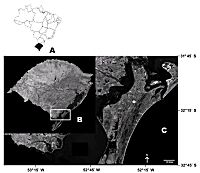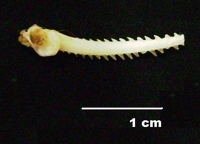IUCN/SSC Otter Specialist Group Bulletin

|
IUCN/SCC Otter Specialist Group Bulletin Volume 27 Issue 1 Pages 1 - 57 (January 2010) Citation: Porciuncula, R.A. and Quintela, F.M. (2010). A Record of Invasive Black Catfish (Trachelyopterus lucenai) Predation by the Neotropical River Otter (Lontra longicaudis) in Restinga of Rio Grande, Southern Brazil . IUCN Otter Spec. Group Bull. 27 (1): 50 - 53 A Record of Invasive Black Catfish (Trachelyopterus lucenai) Predation by the Neotropical River Otter (Lontra longicaudis) in Restinga of Rio Grande, Southern Brazil Rafael Almeida Porciuncula1 and Fernando Marques Quintela2 1Programa de Pós-graduação Especialização em Ecologia Aquática Costeira da Universidade Federal do Rio Grande, Rio Grande, 96201-900, RS, Brasil, e-mail: rafaelporciuncula@gmail.com. |
  |
|
Abstract: Trachelyopterus lucenai (Siluriformes: Auchenipteridae) is an invasive fish in restinga of Rio Grande, Rio Grande do Sul State, southern Brazil. In April 2007 remains of T. lucenai were found in the stomach of an individual of Lontra longicaudis which was run over near a pluvial channel in the restinga area. The present record contributes to the knowledge on otters predation on exotic/invasive species in aquatic environments. |
| Keywords: Auchenipteridae, predation, stomach content, restinga. |
| Française | Español | Português |
INTRODUCTION
Since the year of 2001, individuals of the black catfish Trachelyopteus lucenai Bertoletti, Silva and Pereira, 1995 (Siluriformes: Auchenipteridae) have been captured during fish inventories conducted in Taim Hydrological System (Garcia et al., 2006), located in the restinga of Rio Grande, about 265 km away from its original area, in northern Patos Lagoon, Rio Grande do Sul State, southern Brazil. According to Garcia et al. (2006) the abundance of this species increased during samples realized in the period from 2001 to 2005, reaching the status of dominant species in pelagic deeper waters in lakes of the Taim Hydrological System. However, previous inventories conducted in the same area (Buckup and Malabarba, 1983; Grosser et al., 1994) did not record this species. Apparently, T. lucenai invaded the limnic systems of Taim in the decade of 1990 and the high abundance and diversity of food items and the habitat features favored its settlement and reproduction in the area (Garcia et al., 2006). Bertoletti et al. (1992) suggest that migration of this species could be associated with tributaries of Uruguay River, opening of irrigation channels and joining of limnic systems during floods.
Trachelyopteus lucenai was described for the Patos Lagoon complex and the basin of the Uruguay River, Rio Grande do Sul State, southern Brazil (Bertoletti et al., 1995; Moresco and Bemvenuti, 2005). Data on habitat occupancy and feeding habits in Patos Lagoon complex reveal its occurrence near the margins of lowland tributaries with slow current water and muddy bottom (Bertoletti et al., 1995, Garcia et al., 2006), while diet is omnivorous with a tendency towards piscivory (Becker, 1998; Garcia et al., 2006).
On April 25th, 2007 remains of T. lucenai were found in the stomach of an individual of neotropical otter river Lontra longicaudis which was run over on the road BR 471 (32°12’541”S; 52°27’243”) near a pluvial channel, about 42 km away from Taim Hydrological System, city of Rio Grande, southern Rio Grande do Sul State (Figure 1). The individual was an adult male presenting head-body length 79cm; tail length 52cm and body mass 12.5 kg. The stomach content was removed and preserved in formaldehyde 10%. The feeding remains were compared to specimens of T. lucenai stored in the ichthyologic collection of Ichthyology Lab of Universidade Federal do Rio Grande – FURG. The identification was confirmed by the similarities of pectoral spines morphology (Figure 2) and skin color patterns between feeding remains and stored specimens.
Although other siluriformes species have been found in scats and feeding remains of L. longicaudis in a stream in restinga of Rio Grande (Quintela et al., 2008), this is the first record of predation on T. lucenai. Once T. lucenai was the only item present in the analyzed stomach content, it could represent an important prey to L. longicaudis in the area. The black catfish quickly became the dominant species of pelagic waters in Taim Hydrological Station (Garcia et al., 2006), concerning artisanal fishermen of surrounding areas who attribute no commercial value for the species (Moresco and Bemvenuti, 2005; Bemvenuti and Moresco, 2005). Furthermore, the economic exploited characid Oligosarcus jenynsii was found in stomach contents of T. lucenai from Taim Hydrological System (Moresco and Bemvenuti, 2005).
Predation on exotic or invasive species by otters has been reported for crabs (Weber, 2008) and fishes (Passamani and Camargo, 2005; Helder-José and De Andrade, 1996; Kasper et al., 2004). The present record contributes to knowledge on otters predation on exotic/invasive species in aquatic environments.
Acknowledgements - We are grateful to Alexandre M. Garcia and Michele N. Lopes for accessing the ichthyologic collection of Ictiology Lab of Universidade Federal do Rio Grande – FURG.
REFERENCES
Becker, F.G. (1998). Feeding habitats of Trachelyopterus lucenai (Pisces, Auchenipteridae) in Lake Guaíba, RS, Brazil. Biociências 6: 89-98.
Bemvenuti, M.A., Moresco, A. (2005). Peixes - áreas de banhados e lagoas costeiras do extremo sul do Brasil. Associação Brasileira de Recursos Hídricos, Porto Alegre.
Bertoletti, J.J., Pereira, E.H.L., Silva, J.F.P. (1992). Nota sobre o gênero Trachelyopterus Valenciennes, 1840, no estado do Rio Grande do Sul, Brasil. (Siluriformes, Auchenipteridae) Comun. Mus. Ciênc. Tenol. PUCRS, Série Zool. 5: 169:177.
Bertoletti, J.J., Pezzi da Silva, J.F., Pereira, E.H.L. (1995). A new species of the catfish genus Trachelyopterus (Siluriformes, Auchenipteridae) from southern Brazil. Revue Fr. Aquariol. 22(3-4): 71-74.
Buckup, P.A., Malabarba, L.R. (1983). A list of the fishes of the Taim Ecological Station, Rio Grande do Sul, Brazil. Iheringia: Sér. Zool. 63: 103-113.
Garcia, A.M., Bemvenuti, M.A., Vieira, J.P., Marques, D.M.L.M., Burns, M.D.M., Moresco, A., Condini, M.V. (2006). Checklist comparison and dominance patterns of the fish fauna at Taim Wetland, South Brazil. Neotrop. Ichth. 4(2): 261-268.
Grosser, K.M., Koch, W.R., Drugg-Hahn, S. (1994). Ocorrência e distribuição de peixes na estação ecológica do Taim, Rio Grande do Sul, Brasil (Pisces, Teleostomi). Iheringia, Sér. Zool. 77: 89-98.
Helder-José, De Andrade, H.K. (1997). Food and feeding habits of neotropical river otter Lontra longicaudis (Carnivora, Mustelidae). Mammalia 61:193-203.
Kasper, K.B., Feldens, M.J., Salvi, J., Grillo, H.C.J. (2004). Estudo Preliminar sobre a ecologia de Lontra longicaudis no Vale do Taquari, Sul do Brasil. Rev. Bras. Zool. 21(1): 65-72.
Moresco, A., Bemvenuti, M.A. (2005). Morphologic features and feeding analysis of the black catfish Trachelyopterus lucenai Bertoletti, Pezzi da Silva and Pereira (Siluriformes, Auchenipteridae). Acta Limn. Bras. 17(1): 37-44.
Passamani, M., Camargo, S.L. (1995). Diet of the river otter Lutra longicaudis in Furnas Reservoir, south-eastern Brazil. IUCN Otter Spec. Group Bull. 12: 32-34.
Quintela, F.M., Porciuncula, R.A., Colares, E.P. (2008). Dieta de Lontra longicaudis (Olfers) (Carnivora, Mustelidae) em um arroio costeiro da região sul do Estado do Rio Grande do Sul, Brasil. Neotrop. Biol. Cons. 3(3): 119-125.
Weber, A. (2008). Predation of invasive species chinese mitten crab (Eriocheir sinensis) by Eurasian otter (Lutra lutra) in the Drömling Nature Reserve, Saxony-Anhalt, Germany. IUCN Otter Spec. Group Bull. 25(2): 104-107.
Résumé: Un Record de Prédation du Silure Noir Invahisseur (Trachelyopterus lucenai) par la Loutre Neotropical (Lontra longicaudis) dans la Restinga du Rio Grande do Sul, au Sud du Brésil.
Le Trachelyopterus lucenai est une espèce de poisson envahisseur dans la Restinga de Rio Grande, l´État du Rio Grande do Sul, au sud du Brésil. Em avril 2007 des restes de T. lucenai ont été trouvés dans l’estomac d’une loutre morte écrasée par une voiture proche du canal pluvial dans la zone de Restinga. L’actuel rapport contribue à la connaissance de la prédation des loutres sur les espèces exotiques/invasives dans les écosystèmes aquatiques.
Revenez au dessus
Resumen: Un Registro de la Depredación del Pez Gato Invasor (Trachelyopterus lucenai) por la Nutria Neotropical (Lontra longicaudis) en el Bajío de Rio Grande, Sur de Brasil.
Trachelyopterus lucenai (Siluriformes: Auchenipteridae) es una espécie de pez invasor en el bajío de Rio Grande, Estado de Rio Grande do Sul, sur de Brasil. En abril de 2007, restos de T. lucenai fueron encontrados en el estómago de un individuo de Lontra longicaudis, que ha muerto atropellado cerca a un canal pluvial en el área del bajío. El presente registro contribuye al conocimiento de la depredación de las nutrias en las especies exóticas / invasoras en los ecosistemas acuáticos.
Vuelva a la tapa
Resumo: Um Registro De Predação Do Bagre Negro Invasor (Trachelyopterus lucenai) Pela Lontra Neotropical (Lontra longicaudis) Na Restinga De Rio Grande, Sul Do Brasil
Trachelyopterus lucenai (Siluriformes: Auchenipteridae) é uma espécie de peixe invasor na restinga de Rio Grande, Estado do Rio Grande do Sul, sul do Brasil. Em abril de 2007 restos de T. lucenai foram encontrados no estômago de um indivíduo de Lontra longicaudis morto por atropelamento próximo a um canal pluvial na área de restinga. O presente registro contribui para o conhecimento sobre a predação de lontras sobre espécies exóticas/invasoras em ecossistemas aquáticos.
Retorne à parte superior

